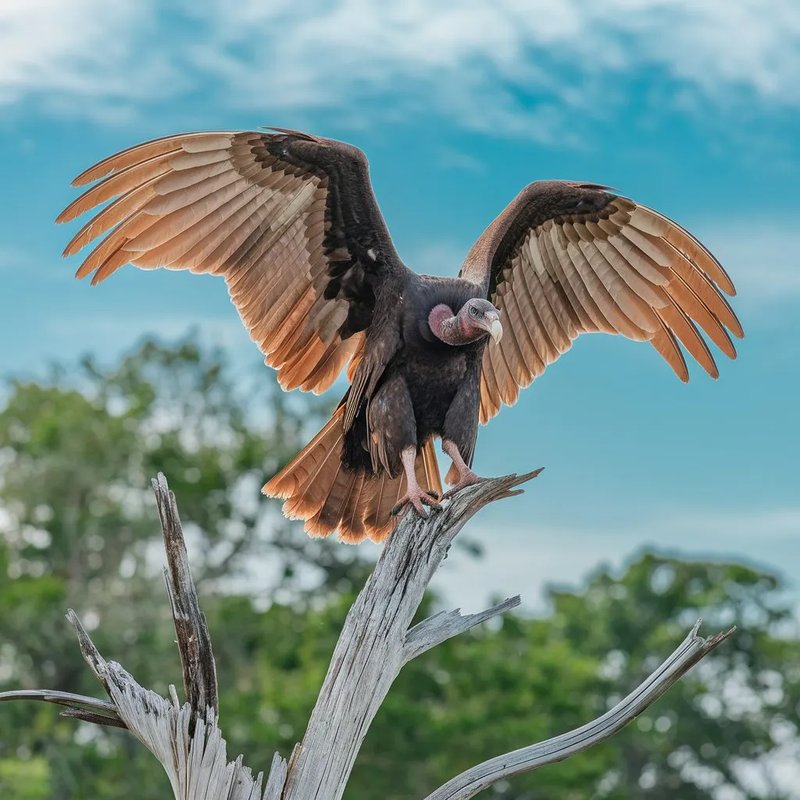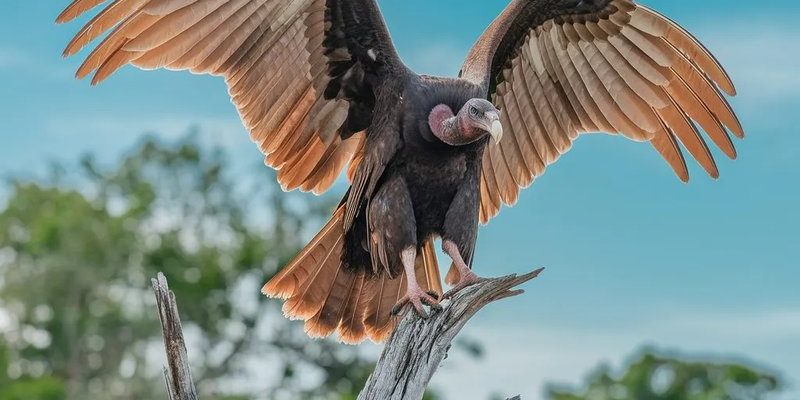
Turkey vultures are not just “the ugly birds that eat roadkill.” They play an essential role in our ecosystems, acting as nature’s cleanup crew. The more we learn, the more we can appreciate their uniqueness. So, let’s take a closer look at some common myths and misconceptions about these incredible creatures.
Myth 1: Turkey Vultures Are Dangerous to Humans
You might have heard some alarming stories about vultures diving at people’s heads or carrying diseases. But *here’s the thing*: turkey vultures are not a threat to humans. While they might seem intimidating when they spread their wings wide, their primary focus is on finding food, mainly carrion. They don’t hunt live animals; that’s just not their style.
When they feel threatened, instead of attacking, turkey vultures often rely on their ability to *disguise* themselves or simply fly away. Unlike some birds that might swoop down aggressively, these vultures would rather avoid confrontation. So, if you see one in your backyard or soaring above, feel free to appreciate their presence instead of being scared!
Myth 2: Turkey Vultures Are Ugly Birds
Let’s face it, many people don’t consider vultures to be the most beautiful birds in the sky. With their bald heads and dark feathers, they certainly don’t have the flashy appearance of a peacock. Still, beauty is in the eye of the beholder. Instead of focusing on their looks, let’s consider their *functionality*. The bald head actually helps these birds maintain hygiene after they feed. Without feathers, it’s easier for them to keep clean, especially since they often indulge in messy meals!
You might even find their unique behaviors entertaining. For instance, they have a fascinating way of soaring high in the sky, using warm thermals to effortlessly glide without flapping their wings too much. Wouldn’t you agree that there’s elegance in their efficiency?
Myth 3: Vultures Are Unclean Animals
It’s easy to label turkey vultures as dirty because they consume dead animals, but this is a misconception that overlooks their critical role in the ecosystem. By eating carrion, turkey vultures help prevent the spread of disease and keep the environment clean. Imagine being the person who picks up after a party—without you, the mess would just pile up. That’s pretty much what these vultures do for nature!
Plus, turkey vultures have a highly developed sense of smell, allowing them to locate rotting animals from miles away. This keen sense does not only make them effective scavengers, but it also contributes to a healthier habitat. So, rather than thinking of them as unclean, we should appreciate their importance in maintaining balance in nature.
Myth 4: All Vultures Are the Same
There’s a tendency to lump all vultures into one category, but there are actually several species of vultures around the world, each with unique characteristics. Turkey vultures, for example, are different from the black vultures or the griffon vultures you might find roaming elsewhere. Each species has adapted to its environment in distinct ways.
Turkey vultures are particularly known for their impressive flight patterns and their ability to soar for hours without flapping their wings. In contrast, black vultures are more aggressive and social. Understanding these differences helps us appreciate the wide variety of vultures and their roles in nature better.
Myth 5: Turkey Vultures Are a Sign of Death
Seeing a turkey vulture might make you think of something morbid, but they aren’t harbingers of doom. Instead, their presence indicates a thriving ecosystem. Think of them as the custodians of nature, essential for breaking down organic matter and recycling nutrients back into the soil.
Moreover, turkey vultures are often seen near areas where other animals have died, which can lead to this misconception. Instead of viewing them as symbols of death, consider them essential players in the circle of life. They help manage populations of dead animals, which in turn supports healthier wildlife and habitats. It’s a natural rhythm, not anything to fear!
Myth 6: Turkey Vultures Are Not Smart Birds
Contrary to popular belief, turkey vultures are quite intelligent. They exhibit problem-solving skills and have even been seen using tools, like sticks, to help them access food. They have excellent memories, allowing them to remember locations where food sources are plentiful.
Moreover, their social structures show that they can communicate and work together effectively. Take a moment to observe them in action: their interactions with one another reveal a layer of social complexity that many people overlook. These birds are far more than just scavengers; they demonstrate a level of intelligence that would surprise most of us.
Turkey vultures are often misunderstood, wrapped in a cloak of myths that overshadow their true nature. From being seen as dangerous to being labeled as unclean, these birds play essential roles in our ecosystems. They are vital scavengers that help keep our environment balanced and healthy. By debunking these common misconceptions, we can foster a better understanding and appreciation for these remarkable birds.
So, the next time you spot a turkey vulture soaring overhead, take a moment to admire the role they play in nature’s cycle. They may not be everyone’s idea of a beauty queen, but they surely deserve a spot in the spotlight for their unique contributions to our world.

